Rhythmic Gymnastics Dream Team - Music & teamwork challenge
Become the coach of a world-class rhythmic gymnastics team.
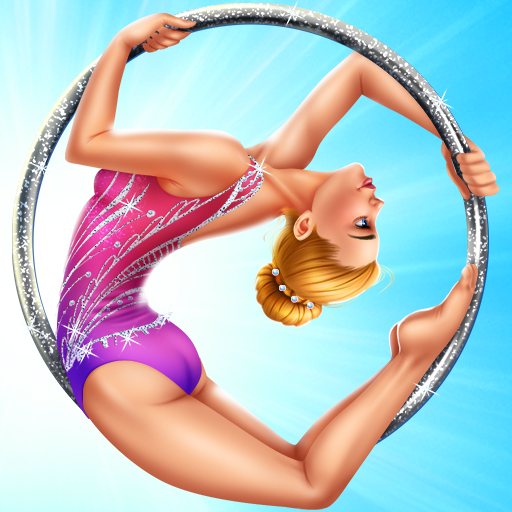
- 1.1.7 Version
- 4.6 Score
- 5M+ Downloads
- In-game purchases License
- 12+ Content Rating
Dear Coco Players
Search no more, the opportunity to unlock 25+ of our games with only one subscription has found you!
This CrazyLabs Pass offers everything you’ve ever dreamed of:
- No Ads
- Everything unlocked
- Shared on 10 of your devices
- Unlimited fun
- Endless joy
Become part of this CrazyLabs Pass and enjoy it to the fullest!
Become the most fantastic rhythmic gymnastics superstar the world has ever seen and dance your way into the hearts of millions! Dress up in stunning dolly rhythmic gymnastics outfits and wow the crowd. Choreograph your routine & rise through the ranks of the competition leaderboard as you compete for your country.
Now’s your chance to show your sweet doll dress up outfits and become a rhythmic gymnastics superstar girl, in the biggest dance battle competition of the year! Compete in a dream team of the best rhythmic superstar gymnast girls as you twirl with ribbons and watch your amazing teammates leap through hoops and dance with balls. Dance your way up from small dance school local tournaments to huge international gymnast tournaments! Represent your country and become a gymnastics queen! Awe the judges!
Game features:
* Dance
Create your very own rhythmic gymnastics ribbon routine by combining ballet and gymnastics.
* Challenge
Compete in an awesome superstar girl team of stellar rhythmic Olympic gymnasts! Leap, twirl, and win every dance battle to reach the top of the charts! Represent your country by showcasing your skills as a gymnast and ballerina!
* Doll Dress up
Dress up like a true rhythmic gymnast superstar girl in eye-catching dress up leotards. Dress up time is never complete until you get a beautiful doll makeover and a princess hairstyle to complete your magnificent dolly look.
* Get fit
Get in shape at the gym. Chill out at the spa, enjoying a gymnastics queen treatment, so you’re all fresh and ready for the big competition.
* Get ready
Ouch! Gymnastics injury. No worries - get treated at the doctor.
* Become a star
OMG! You get to star on the cover of a gymnastics magazine! Create the perfect sweet doll style for the photo shoot by choosing a picture-perfect leotard!
Dance game enthusiasts, step into the world of Rhythmic Gymnastics where ballet and gymnastic moves converge in breathtaking harmony!
How to Do Rhythmic Gymnastics
Co-authored by Emilia Richeson-Valiente and Sophia Latorre
Last Updated: February 7, 2024
Rhythmic gymnastics is an Olympic sport in which athletes compete with 5 different apparatuses—hoops, ribbons, balls, ropes, and clubs—as well as in a floor routine.[1] Whether you have dreams of bringing home the gold medal or are simply interested in trying something new, rhythmic gymnastics is a fun and challenging sport that allows you to be both creative and innovative.
Part 1
Starting Rhythmic Gymnastics
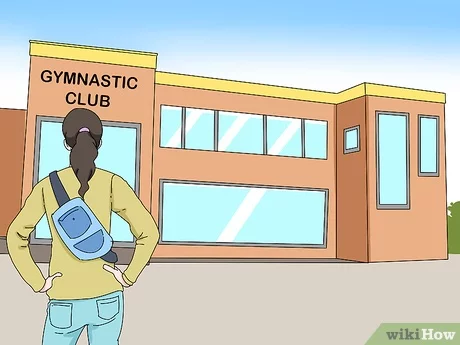
1
Join a rhythmic gymnastics club in your area. Consider the distance from your home, cost of classes, and training schedule when choosing a club. Visit the club and make sure the equipment, including the mats, are in good condition and are cleaned often. The gym should also have multiple coaches with rhythmic gymnastics training and experience that focus on safety above all else.
- If you are looking to compete seriously in rhythmic gymnastics, ensure the gym has advanced training tools, like a pit, trampoline, and tumble-track.
- Do an Internet search to find clubs in your area if you live outside the U.S.
- The cost of classes can vary widely. Contact a few local gyms to see what classes cost in your area.
- Some schools offer rhythmic gymnastics programs. This can help lower some of the costs for kids and adolescents.
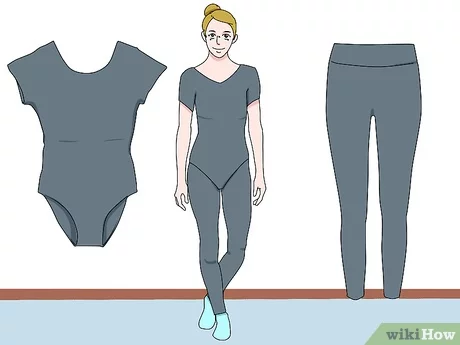
2
Adhere to the club’s dress code. Generally, to practice, rhythmic gymnasts wear a black dance-style leotard with black leggings or shorts. No jewelry is permitted and your hair must be tied back neatly, usually in a bun. You can wear toe shoes (also called half shoes which aid in turning) or go barefoot for both practice and competition.
- For competition, rhythmic gymnasts wear a beautifully decorated unitard or rhythmic leotard with a short skirt.
- Practice your routine a few times in your competition outfit so you can work out any issues if necessary.

3
Get the necessary supplies. When starting out, the gym will generally provide the apparatuses, but you should purchase your own if you plan to practice at home. You may also want toe shoes, a variety of leotards, adhesive tape to decorate your apparatuses, and a ribbon roller. Choose a high-quality gym bag to carry all your equipment and supplies.
- Expect to pay between $100 and $200 USD for a set of all 5 apparatuses, depending on the quality.
- Toe shoes cost around $35, training leotards are about $20, and competition leotards range from $100 to $300 each.
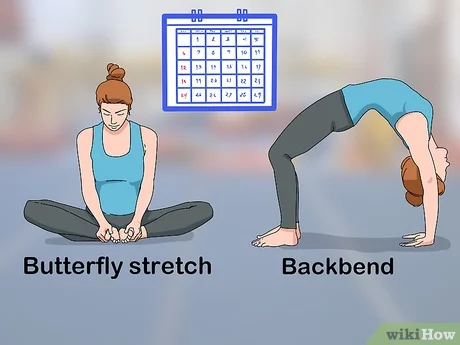
4
Exercise outside of class. If you want to be a rhythmic gymnast, you’ll need to dedicate yourself to practicing. Even if you don’t always visit the club or take classes, aim for 360-minute exercise sessions per week outside of the gym. You should also stretch for 40 minutes every day to increase your flexibility.[2]
- Do the butterfly stretch, a backbend, or arm exercises.
- You can also swim, jog, or ride your bike.

5
Eat healthy. You’ll need to eat healthy to keep your body in good shape and ensure that you are getting all the calories, vitamins, and nutrients your body needs. Aim to eat lean proteins, such as chicken and fish, and lots of veggies, like eggplant, leafy greens, and carrots. You can have small amounts of fruit, including berries and melons, and grains, like cereals or breads, too.
- Make sure you are drinking at least 11.5 cups (2.7 liters) of water per day to stay hydrated.
Part 2
Using the Apparatuses
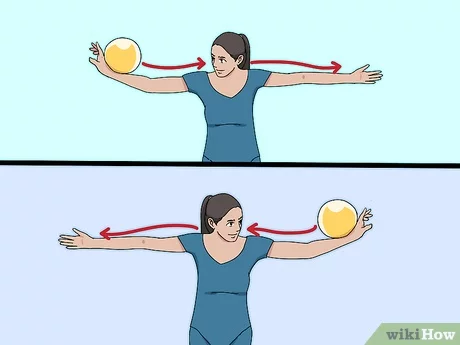
1
Try the ball. Gymnasts usually start with the ball as their first apparatus. A ball routine will include bouncing, throwing, and rolling. Practice rolling the ball from one hand, down your arm, across the back of your neck, and down the other arm. You can also throw the ball high up in the air and catch it with your legs or feet. Try throwing the ball and completing a trick, like a front walkover, then catching the ball.[4]
- The ball is usually made of either rubber or synthetic rubber. It has a diameter of 18 to 20 cm (7.25 to 8 in) and must weigh above 400 g (0.9 lb). The ball can be any color.
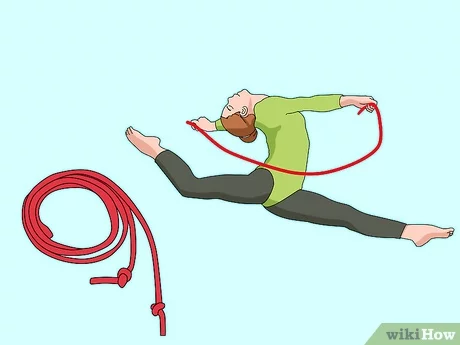
2
Use the rope. Leaps, skipping, swings, throws, circles, rotations, and figure eights are included in a rope routine. Practice doing turns or spins while jump roping, or twirl or toss the rope while doing tricks, like the splits. You could also do a cat or stag leap over the rope.[5]
- The rope is generally made of hemp or a similar material, and the length varies depending on the height of the gymnast. One or two knots are tied on each end to aid in holding on to the rope, which must be either all or partially colored.
- Stand with both feet on the middle of the rope and hold the ends up alongside your body. The ends of the rope will fit directly under each armpit if it is the right length.

3
Practice with the hoop. A hoop routine includes rotations, rolling, swings, circles, throws, and passes of the body through and over the hoop. Try to throw the hoop up in the air and do a trick, like a cartwheel, before catching it. You can also toss the hoop in front of you and dive through it or rotate the hoop around the ankle while doing a back walkover.[7]
- The hoop may be made of wood or plastic and can be any color. The hoop should be between 51 to 90 cm (20 to 35.5 in) in diameter, and it must weigh at least 300 g (0.66 lb).
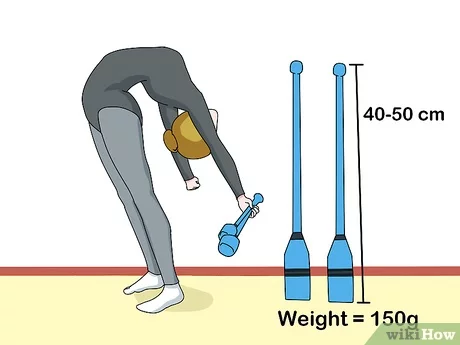
4
Learn how to use the clubs. Two clubs are used and may be juggled, tossed, or thrown. Swing them around and practice completing turns or tricks after you toss them up in the air. You can also toss and catch the clubs then move into a trick, like a dive roll or a handstand.[8]
- The clubs may be made of wood or synthetic material. The length of each club is from 40 to 50 cm (15.75 to 19.66 in). Each club must weigh above 150 g (0.33 lb) and is typically weighted on each end. The shape is similar to a bottle. The neck and head may be covered with adhesive tape.
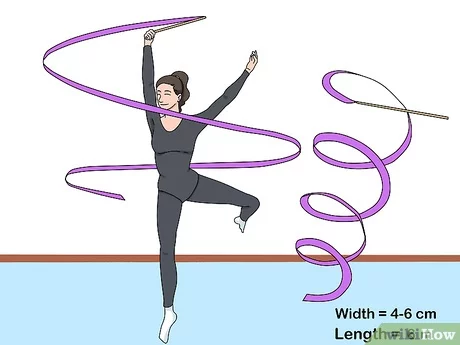
5
Try out the ribbon. The ribbon is one of the most popular—and difficult—apparatuses. Practice making patterns with your ribbon, like spirals or zigzags, but be careful not to get a knot in it. You can also manipulate the ribbon while doing tricks, like pirouettes and penche.[9]
- The ribbon itself may be satin or another non-starched material. It may be any color, and it must weigh at least 35 g (1.25 oz). The width of the ribbon should be 4 to 6 cm (1.5 to 2.4 in). The length from one end to the other must be at least 6 m (20 ft). The stick may be made of bamboo, wood, plastic, or fiberglass.

6
Practice your “free” routine. You will also do a free routine to show your gymnastics skills via a floor routine set to music. There is no apparatus required for the free routine. Show off your elbow stand, front walkover, forward roll, chest stand, or cartwheel while you dance to the music.
Part 3
Improving Your Skills
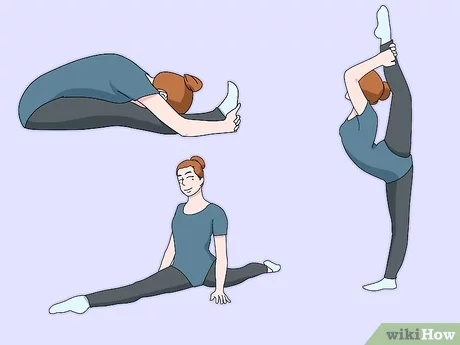
1
Become more flexible. A key aspect of rhythmic gymnastics is flexibility. Stretch for 40 minutes every day so that you can increase your flexibility. Do pointe stretches, the pike, the needle, and the splits. Also work on your bridge and backbend.
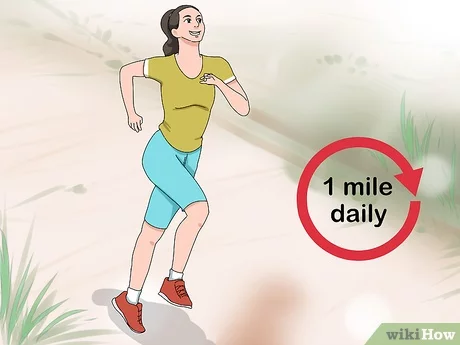
2
Improve your endurance. Rhythmic gymnasts are constantly moving and performing tricks back to back. To increase your endurance, run a mile each day, then perform one of your routines immediately afterward. You can also practice performing several of your routines back to back.[12]
- Track the time it takes you to run a mile to see if you are making progress. For instance, if you started out at 10 minutes and have shortened the time to 8 minutes in the course of a month or so, you’re on the right track.
- If you’re consistently sore or if your joints hurt, you may be pushing yourself too far.
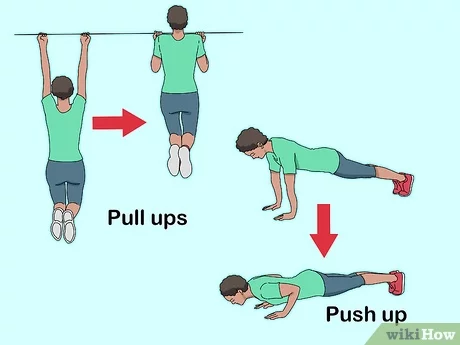
3
Increase your strength. Rhythmic gymnastics requires incredible strength, so you should do weight training to strengthen your muscles. Aim to strength train for 60 minutes 3 times a week. Do pull ups and push ups, along with crunches and planks. Also try squats and lunges.[14]
- Doing ballet is a great way to increase your strength as well as your agility and balance.

4
Improve leaps and jumps. Leaps and jumps are a crucial part of rhythmic gymnastics. The difference between a leap and a jump is while a jump starts and lands on two feet, a leap takes off of one foot and lands on the other. With this display of flexibility along with the look and feeling of weightlessness, rhythmic gymnasts spend much of their time on these elements. Once you have a single jump or leap down, practice combinations. Some types of jumps and leaps to master are:[15]
- Split leap and a split jump (jump with a split at the height).
- Straddle leap and straddle jump (also known as side leap or jump).
- Leaps or jumps with twists (where a turn is added while in the air).
- Donut or sheep jump (the gymnast touches their head with both feet).
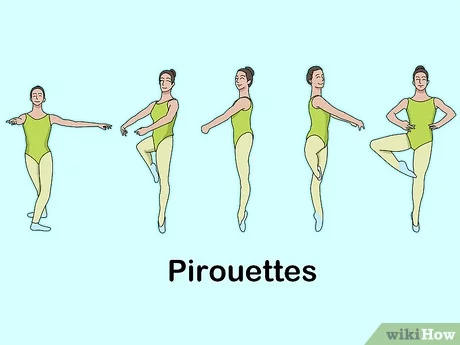
5
Work on your turns. Along with leaps, turns are something that rhythmic gymnasts focus on. Turns often include more than one rotation, and improving your balance will help when learning turns and pirouettes. Master single turns before trying doubles, triples, or combinations. Some turns to aim to learn are:[16]
- Fouettés (often done en tournant or a la second).
- Pirouettes (including double or triple pirouettes).
- Ring turn (a turn in a needle position).
Expert Q&A
How can I tell if rhythmic gymnastics is the sport for me?
Michele Dolan:
*Certified Fitness Trainer
If it is for you, you will want to do it more than any other activity and you will love the training, and look forward to all the practices.
How many hours a week does a rhythmic gymnast train?
Michele Dolan:
*Certified Fitness Trainer
This varies based on your age and your level. A beginner might train for 4 hours a week and an advanced competitive gymnast might train for 4 hours a day. Start with an amount of training that fits with your life and your energy levels and budget.
I am 12. I have done rhythmic gymnastics from the age of 3 to the age of 11. I left gymnastics at the age of 11. Is it a good idea to start it again?
Sarah:
*Community Answer
Definitely! If you've trained for so long, you should continue if you still enjoy it.
- Version1.1.7
- UpdateSep 09, 2024
- DeveloperCoco Play By TabTale
- CategoryRole Playing
- Requires AndroidAndroid 6+
- Downloads5M+
- Package Namecom.cocoplay.gymnastics.simulator
- Signature76a77ff51a9d041c2e1bda1466b121b8
- Available on
- ReportFlag as inappropriate
-
NameSizeDownload
-
183.93 MB
-
183.45 MB
-
183.45 MB






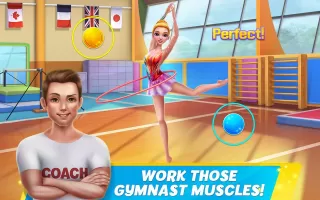

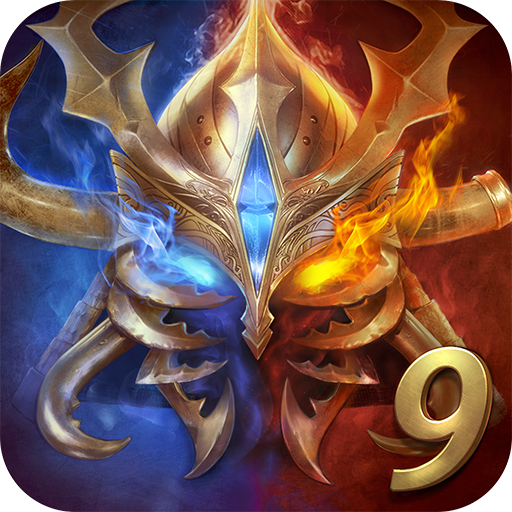



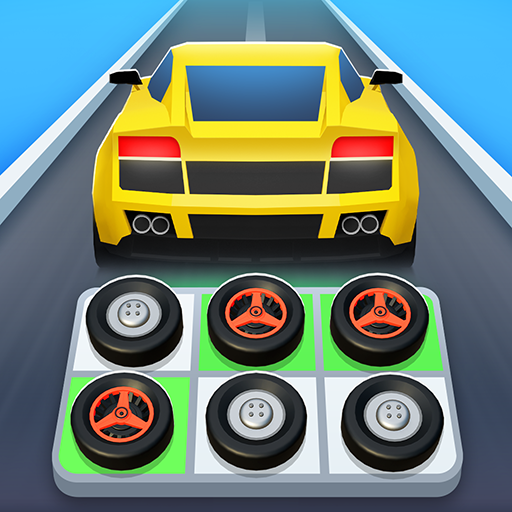

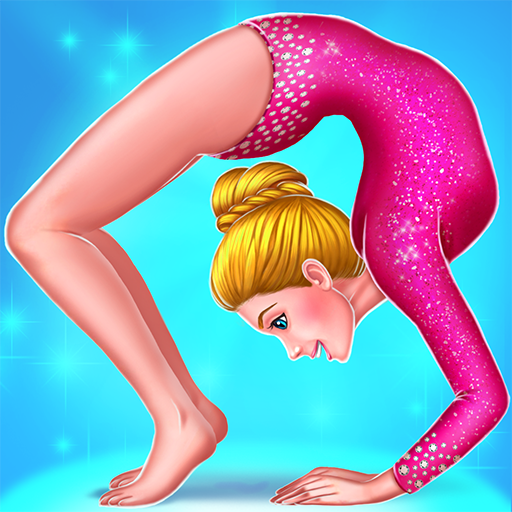
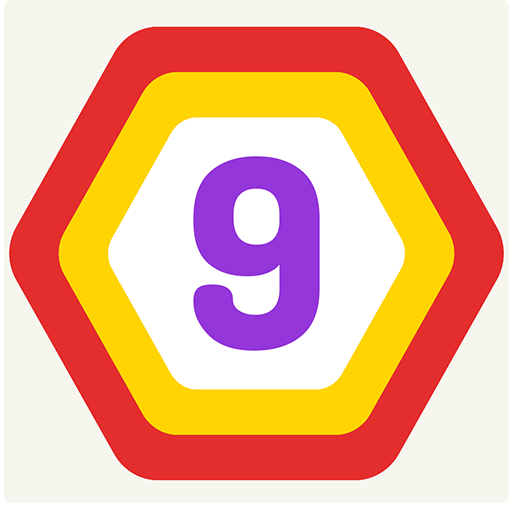
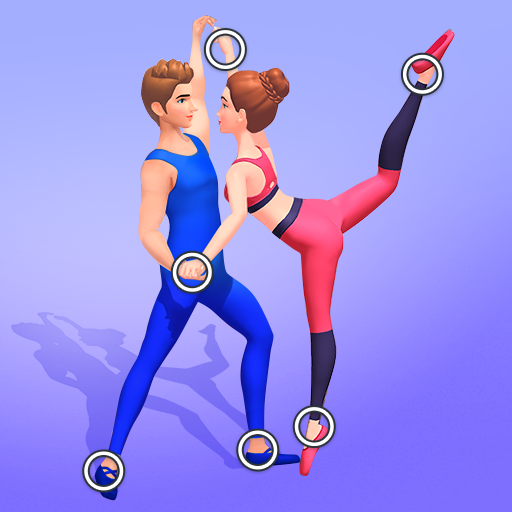














very cool graphics and the character
the movements are beautiful
add mini games suggested
multiple player mode would be great